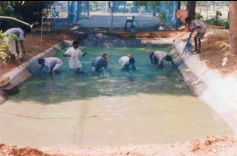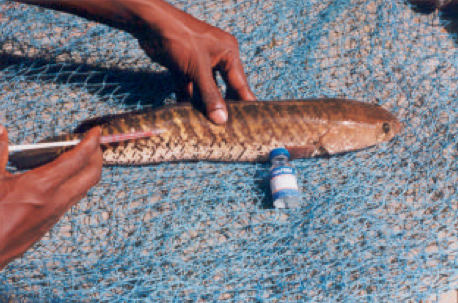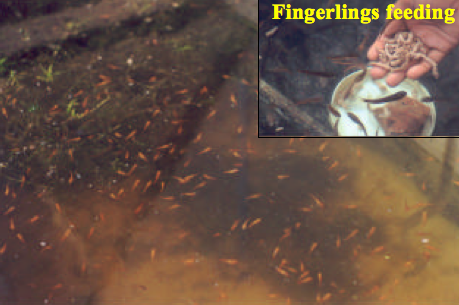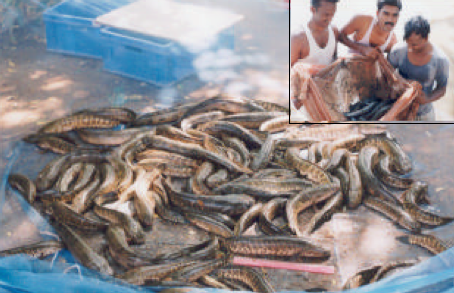|
Murrel culture is about four decades old and in our country with the first demonstration in Madras at Sunkesula fishfarm (now in AP) by the State Fisheries Department. Further attempts made by the State Fisheries Departments of Hyderabad and Bombay and CIFRI Bhadra Centre (Karnataka) have not produced tangible results. Moreover fish farmers who have attempted murrel culture semi scientifically have not succeeded, since they have come across severe mortality due to epizootic ulcerative syndrome. Hence a technology package for murrel culture was developed and successfully demonstrated by the Centre for Aquaculture Research and Extension (CARE) with the financial assistance from the Department of Science and Technology (SSP/RD/ 001/96). The system developed and adopted involves all relevant aspects of murrel culture viz., brood fish nutrition, mass seed production, rearing of young ones and culture. The Centre for Aquaculture Research and Extension is providing commercial murrel culture training to unemployed youths and fish farmers for income generation. Some of the trainees have already implemented the technologies in their localities and succeeded in their culture practices.
Advantages
The technology developed for murrel culture has several advantages.
- Eggs are obtained at any time irrespective of the
monsoon
- High quality fingerlings are available to fish farmers according to their requirement.
- Good quality murrels are obtained throughout the
year.
- Unemployed youths get blue-collar jobs and fish
farmers are provided higher income.
- Conservation of the threatened species is ensured through artificial propagation.
Conditions for Feasibility
Project area of at least 50 square meter (10m x 5m) is essential for murrel culture.Water supply from nearby bore well or any other source must be available.Bio wastes like chicken intestine or fish waste must be available.
Technology Package
Brood fish nutrition : Quality and quantity of feed as well as feeding regime are important for spawning and egg quality. A suitable package of diets using chicken intestine (70% protein) followed by fish waste (56% protein) and beef liver (63% Protein) was suggested for a maximum spawning of more than 6000 eggs with 90% fertilization and hatching. Chicken intestine was recommended as a suitable diet for brood fish.
Brood stock pond preferably of rectangular shape (6m x 5m x 1m) facilitates effective netting operations and convenient for maintenance of brood fishes. A minimum depth of 1 m is enough and the recommended stocking density is (10,000 /ha). |
 |
Induced breeding and seed production : Females with soft and swollen bellies are suitable for breeding. However a gentle pressure on the belly for oozing of eggs could check prime maturation.
Males are selected by external examination of genital papilla since they do not ooze milt by pressure. Murrels are induced to spawn by injecting natural (pituitary, human chorionic gonadotropin) or synthetic (ovaprim, ovatide) hormones intramuscularly.
Among the hormones tested by the CARE research team, ovaprim, a synthetic product of SGnRHa marketed by Glaxo Ltd is recommended at a single dose of 0.5 ml/ Kg.
Each breeding set consists of one female and two males.Immediately after injection each breeding set is introduced into a breeding tank (6m x 5m x1m) having sides pasted with cement and bottom filled with clay. Aquatic weeds (e.g. water hyacinth) are introduced into the breeding tank for hiding purposes.
Spawning activities are observed after 6-10 hrs of hormone injection. Courtship behaviour continues till the complete release of eggs and milt (24-30 hrs). Fertilization is external and the fertilized eggs are usually floating. An egg mass of about 6-14 cm diameter consists of 5000-10,000 eggs (diameter 1.2mm -1.5mm).
The rate of fertilization ranges between 70 -90%. Hatching takes place 24-30 hrs after fertilization and the hatchlings (2.8mm - 3.2mm in length) are guarded by the parents especially by the male parent. From a single spawning 4000-8000 hatchlings/female are obtained. |
 Induced Breeding Induced Breeding |

Fry breeding |
Rearing of young ones : The yolk sac is completely absorbed on the 3rd day and the mouth is fully formed. At that time the larvae start exogenous feeding especially on small plankton like rotifers. The young ones are allowed to stay with parents in the breeding tanks for one or two weeks. To avoid cannibolism the fry are removed from breeding tanks after two weeks. The fry are fed with boiled and finely ground chicken intestine or fish waste. After a month the fry (15mm length) attains red colour. The fry are reared in cement tanks (3m x 1m x 1m) with a stocking density of 500/m . Whenever the young ones are reared, they should be of equal size to avoid cannibalism.
Fry survival may be 65-80% in the cement tanks. Water quality (29 ± 10C, 0.06 - 6.52mgO2/l pH 7.5 - 8.2) and feeding are the deciding factors for the survival of the young ones. A flow through system is always preferred for better survival. The fry are reared in medium (3m x 1m x 1m) or large cement (5m x 4m x 2m) tanks upto the fingerling stage. The fry reaches 4 to 5 cms after 2 months and the fingerlings are collected from the cement tanks for commercial culture. |
 |
Murrel culture : To popularizes commercial murrel culture among fish farmers and unemployed youths earthen ponds of different dimensions (15m x 5m x 1m) have been excavated at the CARE aquafarm. These earthen ponds are cement pasted at the sides and filled with clay at the bottom (25 cm). They are filled with water for a maximum depth of 1m during the north east monsoon (Oct). Fingerlings of equal size (8 cm-10 cm; 5.8-12.0 g weight) (12,000-15000/ha) are released into these ponds during October and are fed on boiled chicken intestine (5-10% body weight).
Water is supplied from a bore well daily to adjust the water loss due to seepage and evaporation and to maintain the water level. Water is completely removed once in 3 or 4 months and the murrels are observed for diseases and deformities. After sampling healthy individuals are released into the culture ponds. After 8 months culture period the murrels reach a maximum weight of 800-900g with 90-95% survival. An unemployed youth can earn a sum of Rs. 50,000/- year by starting commercial murrel culture. If they do not have land and water resources they can utilize the neglected water bodies of their area by forming co-operative groups.
The striking feature of this technology package is that each technique can be practiced semi scientifically. At present the SC youths who have undertaken murrel culture training at CARE have implemented murrel culture without depending on seeds from wild collection and obtained good income. |
|
Economics : An appropriate budget for small scale fish farmers is given below. According to availability of land and water, the unemployed youths can excavate earthen ponds. With a minimum area of 600m2 - 750m2 one can earn Rs. 50,000 – 70,000/year.
|
Budjet
Expenses
| |
Type I |
Type II |
|
| 1. Construction of earthen ponds |
| Pond size |
15m x 10m x 1m |
25m x 12m x1m |
|
| No. of ponds |
5 |
2 |
|
| Depth |
1m |
1m |
|
| Total area |
750m |
600m |
|
| Excavation |
Rs.5000/pond |
Rs.10000/pond |
|
| Charges |
25000/5 ponds |
Rs. 20000/2 ponds |
|
| Bamboo fence |
Rs.1000/ponds |
Rs. 4000/2 ponds |
|
| netting etc. |
Rs. 5000/5 ponds |
Rs. 4000/2 ponds |
|
| 2. Fish fingerlings |
| Size (5 cm) |
150/pond |
300/pond |
|
| Number |
For 5 ponds 750 |
For 2 ponds 600 |
|
| Cost of fingerlings
(each Rs. 1/-) |
Rs. 750 |
Rs. 600/- |
|
| 3. Feed cost |
| Chicken intestine / Fish waste |
Nil |
Nil |
|
| Labour |
| Rs. 2000/month -
For 10 months |
Rs. 20000/- |
Rs. 20000/- |
|
| Miscellaneous |
| |
Rs. 2250/- |
Rs. 2400/- |
|
| Total expense |
Rs. 53000/- |
Rs. 46000/- |
|
(Income after 10 months)
(Average survival of 80% with table size of 1 kg and price Rs. 160/kg)
| |
Type I |
Type II |
| No. of table size fish |
600 |
500 |
| Total price |
9600 |
8000 |
| Total Expenses |
53000 |
47000 |
| Net income after 10 months |
43000 |
33000 |
| Net income for every subsequent year |
66000 |
56000 |
Resource Agency
Centre for Aquaculture Research and Extension (CARE)
St. Xavier’s College (Autonomous), Palayamkottai,
Tirunelveli - 627 002. Tamil Nadu.
|


 Induced Breeding
Induced Breeding
